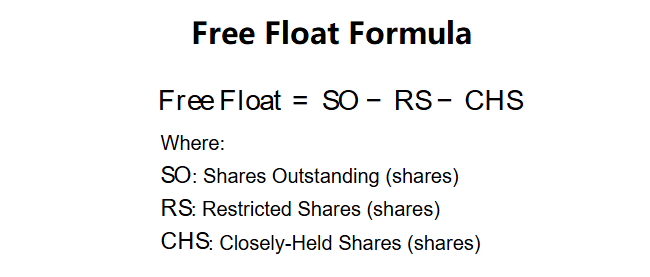1. What is Free Float Calculator?
Definition: This calculator computes the number of free float shares and their percentage, representing shares available for public trading.
Purpose: Helps investors assess stock liquidity and market volatility based on available shares.
2. How Does the Calculator Work?
The calculator uses the following formulas:
Free Float:
\( \text{Free Float} = \text{SO} - \text{RS} - \text{CHS} \)
Where:
- \( \text{SO} \): Shares Outstanding (shares)
- \( \text{RS} \): Restricted Shares (shares)
- \( \text{CHS} \): Closely-Held Shares (shares)
Free Float Percentage:
\( \text{Free Float Percentage} = \frac{\text{Free Float}}{\text{SO}} \times 100 \)
Steps:
- Enter shares outstanding, restricted shares, and closely-held shares.
- Subtract restricted and closely-held shares from total shares to get free float.
- Calculate percentage based on shares outstanding.
- Display with 0 decimal places for shares and 2 for percentage.
3. Importance of Free Float
Calculating free float is crucial for:
- Liquidity Assessment: Indicates how many shares are available for trading.
- Volatility Insight: Lower free float can lead to higher stock price volatility.
- Investment Strategy: Guides institutional investors preferring stocks with larger free float.
4. Using the Calculator
Example 1: SO = 10,000, RS = 2,000, CHS = 1,000:
- Shares Outstanding: 10,000
- Restricted Shares: 2,000
- Closely-Held Shares: 1,000
- Free Float: \( 10,000 - 2,000 - 1,000 = 7,000 \) shares
- Free Float Percentage: \( \frac{7,000}{10,000} \times 100 = 70.00\% \)
- Result: Free Float = 7,000 shares, Percentage = 70.00%
Example 2: SO = 5,000, RS = 500, CHS = 1,000:
- Shares Outstanding: 5,000
- Restricted Shares: 500
- Closely-Held Shares: 1,000
- Free Float: \( 5,000 - 500 - 1,000 = 3,500 \) shares
- Free Float Percentage: \( \frac{3,500}{5,000} \times 100 = 70.00\% \)
- Result: Free Float = 3,500 shares, Percentage = 70.00%
Example 3: SO = 20,000, RS = 5,000, CHS = 10,000:
- Shares Outstanding: 20,000
- Restricted Shares: 5,000
- Closely-Held Shares: 10,000
- Free Float: \( 20,000 - 5,000 - 10,000 = 5,000 \) shares
- Free Float Percentage: \( \frac{5,000}{20,000} \times 100 = 25.00\% \)
- Result: Free Float = 5,000 shares, Percentage = 25.00%
5. Frequently Asked Questions (FAQ)
Q: What is free float?
A: Free float is the number of shares available for public trading, excluding restricted and closely-held shares.
Q: Why is a high free float percentage good?
A: It indicates better liquidity and lower volatility, attracting institutional investors.
Q: Where to find these numbers?
A: Check the company’s balance sheet or shareholder reports for outstanding, restricted, and closely-held shares.
 Home
Home
 Back
Back
